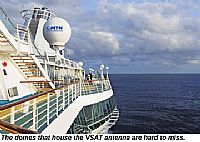Posted on Thursday, February 9, 2012 by
Randy tagged as
internet,
MTN,
satellite,
travel weekly,
wi-fi VSAT antenna onboard |
Each cruise line has its own per-minute prices for Internet service. Below is a sample of prices cruisers will pay to connect on the high seas:
Travel Weekly
By Donna Tunney
 http://www.travelweekly.com/Cruise-Travel/Signal-at-sea/
http://www.travelweekly.com/Cruise-Travel/Signal-at-sea/
Clients book cruise vacations because they want to relax, visit interesting destinations and have fun. But that doesn't mean they won't stay connected to family and friends while they're away.
Many expect to tweet, text, check email and post pictures to social media sites from the middle of an ocean. Indeed, the number of iPads, iPhones and other Web-enabled mobile devices in use by passengers at a shipboard lounge often matches the number of rum punches and martinis on the bar.
For cruise lines, it sounds like a simple win-win situation: They invest in an infrastructure to provide reliable Internet connectivity at sea, making them competitive with land resorts, and the rewards come with per-minute rate packages that contribute to onboard revenue streams.
Bow-to-stern WiFi-enabled ships, a rarity even a few years ago, are commonplace now.
But the rocket science behind the technology that enables at-sea Internet service is complicated. Speed and reliability vary from ship to ship, and more than a decade after Internet service was introduced onto cruise ships, slow connections and breaks in service can still perplex passengers.
In simple terms, shipboard access to the very big Internet relies to a great degree on a Very Small Aperture Terminal (VSAT), a system of above- and below-deck equipment and devices that serve as conduits to satellites 22,000 miles above the Earth's equator.
A VSAT antenna coupled with the amount of bandwidth a cruise ship has available tell the story of onboard Internet connectivity.
Using a VSAT system, data request signals, which occur when someone tries to access a website from a computer onboard a ship, must travel to an orbiting satellite, bounce to an earth station and then travel back to the satellite before returning to the shipboard computer.
It's a 44,000-mile, roundtrip journey, and while experts say it takes only a half-second for a signal to reach a satellite from a shipboard antenna, the start-to-finish connectivity process is considerably slower than a land-based routing.
read the rest of the article  here
here



